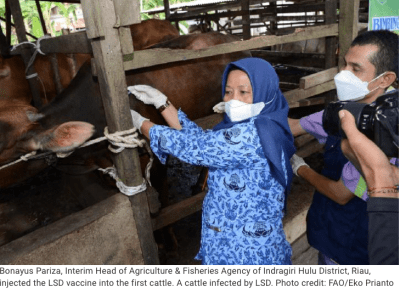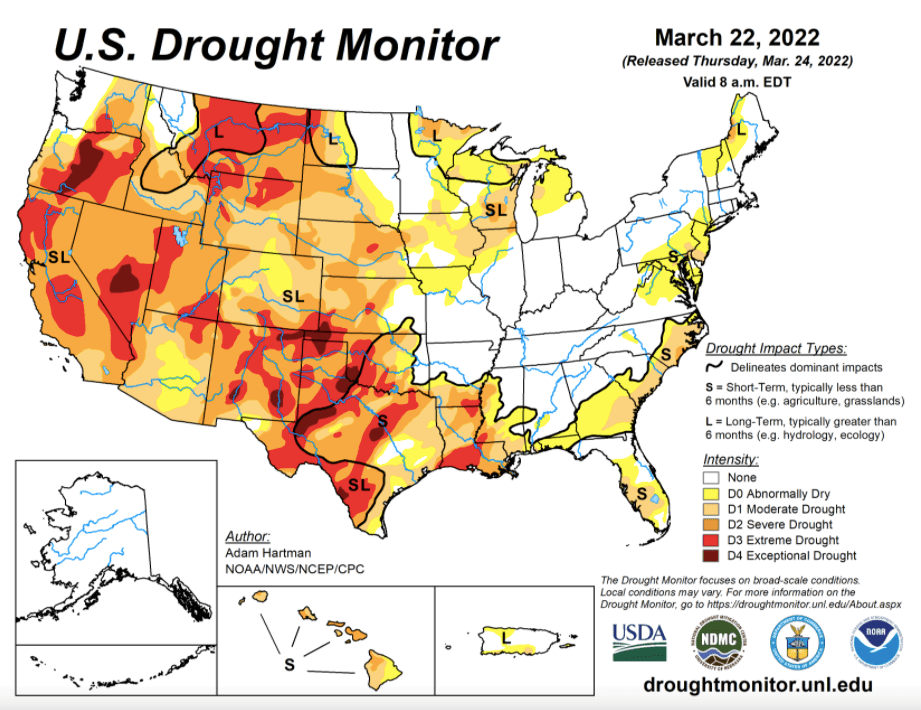
![]() See Bahasa Indonesia translation
See Bahasa Indonesia translation
100th Edition
Key Points
- The war in Ukraine is driving world food inflation much higher
- Australian cattle prices remained strong during March
- Prices predicted to decline in coming months as the wet season fails in northern Australia
- No animals were imported from Australia to Vietnam during March

Global Comment
The world economy was already in a very fragile and vulnerable state before the Covid 19 pandemic made the situation dramatically worse.
The Russia/Ukraine war initially led to a major humanitarian and geo-political disaster but has quickly progressed to a powerful force driving further destabilization in global economic conditions.
The primary external problems caused by the war are further rises in global energy prices in combination with a reduction in the supply of critical commodities such as wheat, corn, sunflower seeds/oil, barley, fertilizer, and crop chemicals.
The reduction in wheat exports from both Ukraine and Russia will have a very serious impact on their main customer countries which are primarily located in the Middle East, North Africa and Asia. Indonesia was the second largest importer of Ukrainian wheat in 2020 with a total value of $544 Million.
China will also be impacted as they are such a large consumer and importer of a wide range of grains including wheat, soybeans and barley. The increases in the price of fuel and fertilizer inputs for this season’s grain crop outside the war zone will mean there will be less grain produced and what product is finally harvested will be selling at much higher prices.
Supply chains, which were already severely disrupted during the pandemic will only deteriorate further until well after the war has been resolved.
Grains not only feed humans with staples like bread, noodles and beer but also feed livestock including chickens, pigs and feedlot cattle. Rising grain prices will therefore force the prices of poultry, eggs, pork and beef to rise while increased fuel prices will add additional freight and production cost to all food items in every country. Rampant food inflation and food shortages are developing quickly and will persist for the next 2 years at the very least even if the war stops tomorrow.
Indonesia: Slaughter Steers AUD $5.05/kg live weight (Rp10,500 = $1AUD)
Slaughter steer prices have increased slightly this month with the indicator rate for March at Rp53,000 per kg live weight. While the majority of sales have been made at close to this price there have been reports of rates as high as Rp57,000 per kg live weight for small numbers of exceptionally high yielding animals.
The Indonesian authorities will no doubt be monitoring these prices very closely at they are especially sensitive to prices above their target rates during the Ramadan/Lebaran festival period which started on the 2nd of April.
By the end of March my reporter in Jakarta advised that the retail wet market price for knuckle had reached Rp160,000 from Rp150,000 in February. Frozen Indian Buffalo meat (IBM) was once again found in the retail market and was selling for Rp98,500 per kg.
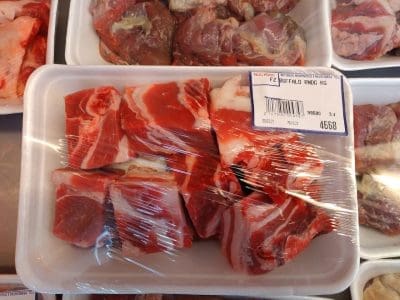
I think this is the best looking frozen Indian buffalo meat that I have ever seen. Considering the price of frozen IBM is so low in India, the question is why is it so expensive by the time it reaches the Indonesian retail shelf?
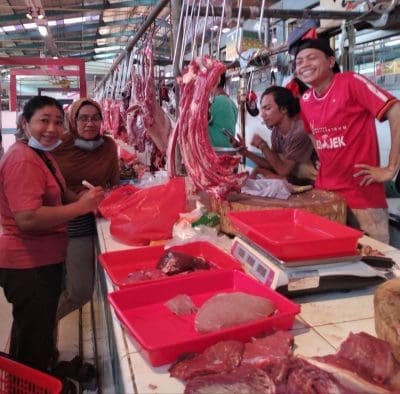
Everyone at this Pasar Modern wet market stall is happy that Ramadan has commenced with demand and prices on the rise. Looks like the heat is off for Covid too with a relaxed attitude to masks.
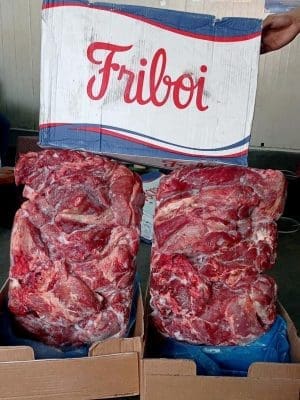
Friboi is the Brazilian brand of beef for JBS. This photo was taken in a wet market in Bandung, West Java.
Lumpy Skin Disease: One of the major concerns during March and on into April and May is that cattle owners in the area of Riau Province, Sumatra affected by Lumpy Skin Disease (LSD) will be facing movement restrictions and severely depressed prices if they are permitted to sell stock at all.
This situation invariably leads to a small but significant level of smuggling from the area where the price is most depressed (Riau, Sumatra) to the area where the demand and price are greatest (West Java).
If this takes place and infected animals are illegally trucked to Java during March/April/May, then the spread of this insect transmitted disease throughout the archipelago will speed up dramatically.
No doubt government authorities will be on extra-high alert throughout the festival period.
Vaccination against LSD commenced in Riau on or about the 19th of March.
As the festival period gets started, all government agencies are doing their utmost to ensure that plentiful supplies of beef and other key foods are available to the public. Government initiatives include:
- Private businesses have been encouraged to import frozen beef directly
- Bulog has accelerated the importation of IBM with 20,000 tons delivered to Indonesian ports by the end of March
- The government is examining possible alternatives for live imports other than Australia including from USA, Chile and Mexico.
ASPIDI (Indonesian meat import employers association) have claimed that if they were permitted to complete importations of IBM themselves then they hoped to be able to reduce the retail price of frozen IBM to Rp65,000 per kg.
The head of the national food agency (Bapanas) has asked for the prices for IBM to be reduced. At the moment distributors are buying from Bulog at Rp81,000 per kg while distributors then sell to retailers for Rp93k (ekonomi.bisnis.com 17th March)
As mentioned at the beginning of this report, Indonesia usually buys a large amount of their grains from Ukraine. See below some graphics produced by the USDA for global wheat, barley and corn exports.
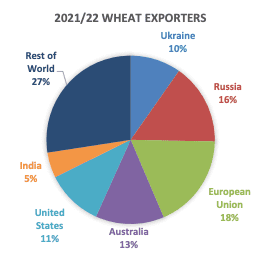
Even if Ukraine can plant its wheat this month, the chances of a normal harvest and then uninterrupted exports to the rest of the world are slim. The Russian crop will no doubt be planted without interference, but will it be exported to their usual customers?
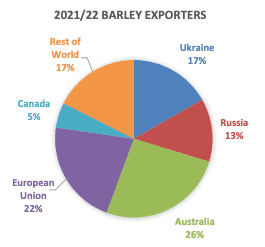
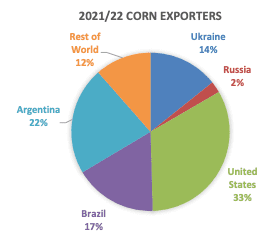
From an Indonesian cattle importer perspective there is only one piece of good news at the moment and that is the disappointing wet season in Northern Australia.
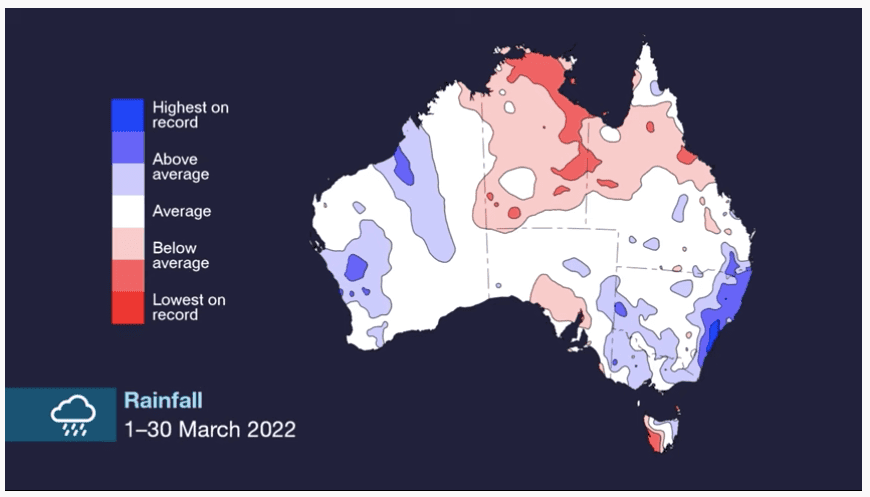
This map from the Australian Bureau of Meteorology highlights the very low levels of rainfall in the north during March.
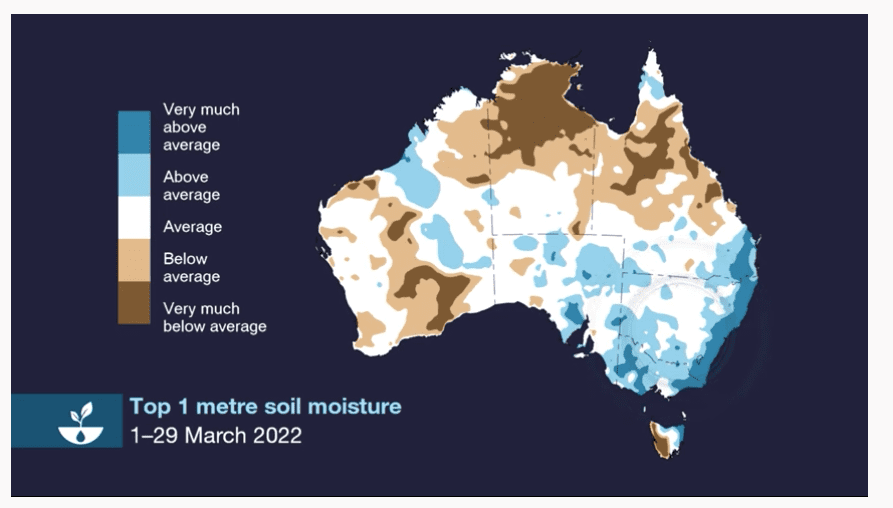
The result of this poor wet season in northern Australia is below average soil moisture which means below average pasture growth.
Unless substantial rains fall during April, producers across the north will commence the reduction in their herds through sales and movements of stock to areas with adequate feed reserves. The bottom line is that this will drive feeder cattle prices down. Sales to reduce grazing pressure across the north could start as early as mid-April and will accelerate into May if the rains fail to arrive.
Darwin feeder steer prices remained firm for most of March with AUD$5.53 still available in the middle of the month. At the end of March agents were predicting a decline to $5 per kg in the beginning of April with further falls to as low as AUD$4.60 if widespread rains have not fallen by the end of Easter (15-18th April). The traditional date for mustering to commence in the north is immediately after Easter so the weather at this time will provide the best guide to prices for the rest of the year. 14,244 head of feeders were exported from the port of Darwin to Indonesia during March. My advice is that no animals were exported from any Australian port to Vietnam.
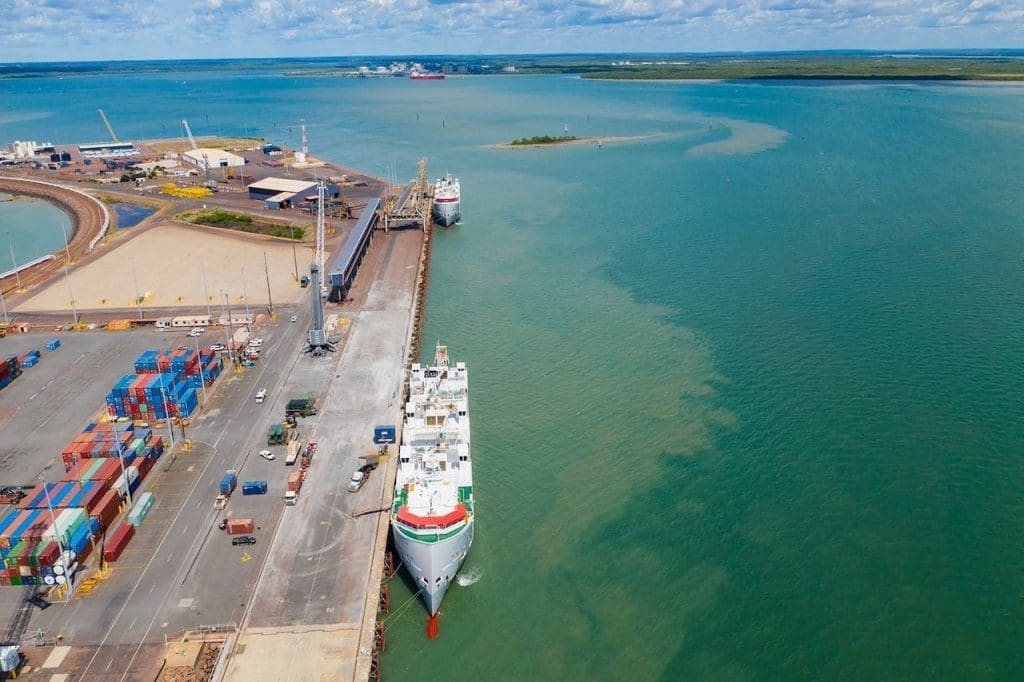
Two Livestock Express cattle ships getting ready do load feeder cattle for Indonesia at the port of Darwin during March. These G class ships are in my opinion the very best vessels in the live export fleet with maximum comfort for both the livestock and their human carers. The new Darwin LNG terminal is in the background.
And the bad news for food production just keeps on coming. See below a number of graphs from the US Department of Agriculture showing the severity of the drought in the USA during March 2022. These dry conditions are having a strong impact on both beef production and cropping and are likely to further reduce global supplies of grain later this year.
The severe drought areas include a large proportion of the US cattle country.
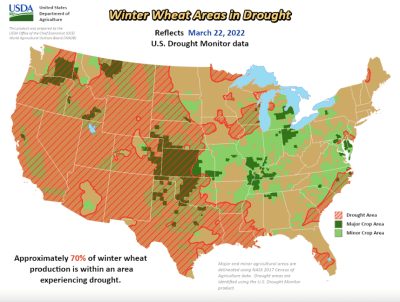
Vietnam: Slaughter Steers AUD $5.00 / kg (VND16,800 to $1AUD)
Slaughter cattle prices remained steady this month at Dong84,000 per kg live weight.
No animals were imported from Australia to Vietnam during March.
The total feedlot capacity is reported to be around 100,000 head. My advice is that the current numbers remaining on feed are in the order of 30pc or 30,000.
The poor wet season in northern Australia provides a small ray of hope for Vietnamese importers but it will take a flood of cattle to hit the market in order to reduce the prices in Queensland to a point where importing becomes profitable once again.
Assuming that 84,000 Dong remains the selling price and that no value adding is possible then cattle would need to be landed in Vietnam with a CIF of AUD$5 to break even.
With a very rough cost of freight and insurance of about AUD$1 per kg this means that slaughter steers and bulls in Queensland would need to be purchased for around AUD$4 per kg live weight in order achieve a CIF of $5.
China: Slaughter Cattle AUD $7.56 / kg live weight (RMB 4.68 = 1AUD$)
This month is remarkable because so little has changed. Both slaughter cattle and beef prices have hardly moved in the last three months.
Slaughter cattle and beef prices remain among the highest in the world but at least they are stable.
The only significant variation is a major fall in pork prices which dropped from Y30.6 per kg in January in both Beijing and Shanghai to Y21.8 in Beijing and Y23.6 in Shanghai in March.
China has massive stockpiles of grains and petroleum products, but their consumption is also enormous so as one the world’s largest importers of both grains and energy, the risk of shortages of both will be increasing as the Ukraine war drags on with no end in sight.
Philippines : Slaughter Cattle AUD $3.34 / kg (Peso 38.3 to AUD$1)
Slaughter cattle prices remain steady at about Peso 128 per kg live weight despite a turbulent month in the Philippines as a result of the Presidential election campaign as well as steep fuel price rises driven by the war in Ukraine.
Every aspect of Filipino life is affected by fuel prices. My agent reports that petrol prices have risen to Peso 64 last week with a recent period of rates as high as P77 per litre. In September 2021 the price of petrol was Peso 41 per litre. The potential for continued rises in fuel prices represents a very serious threat to the entire economy of the Philippines with food inflation centre stage.
Thailand: Slaughter Steers AUD $4.08 / kg (Baht 24.5 to $1AUD)
Slaughter cattle prices declined by 10 percent this month as traders are becoming very wary of increased risks coming from all directions in the market.
Food inflation, rising fuel, grain and fertiliser costs, war in Myanmar and Ukraine all added their destabilising influence to the existing disruptions from Covid 19, LSD and African Swine Fever.
Add global economic weakness, rising interest rates and high levels of debit in the meat trading system and that’s enough to make any producer/trader nervous and cautious.
Laos Railway development
Mike Boddington from Jungle House in Vientiane reported in his March edition of “Laos Leaves” that the rail link from Boten on the border with China to Vientiane was officially opened on the 3rd of December 2021 and has become a huge success. The line runs north from Vientiane through the border to Kunming where it connects with the national Chinese high speed rail network. Large numbers of passengers have already used the service with the major freight item so far being fresh produce moving from Thailand to Kunming.
Passenger trains can travel at 160 km per hour while freight trains have a top speed of 120 km/hour. The Boten-Vientiane railway is an integral section of the central line of the Kunming-Singapore railway and was constructed as part of the Belt and Road Initiative.
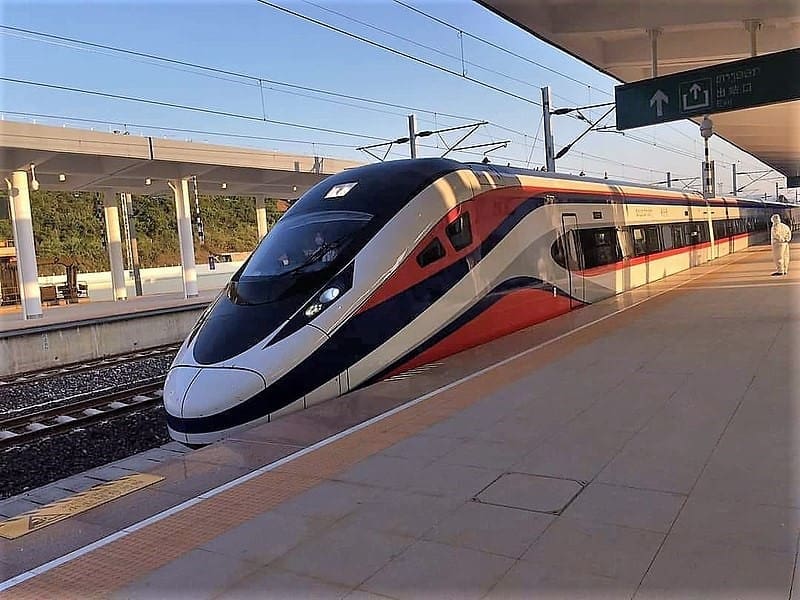
Passenger train at the Vang Vieng station north of Vientiane, Laos.

The new line from Boten in the north to the capital Vientiane is 422km of standard gauge, electrified track.
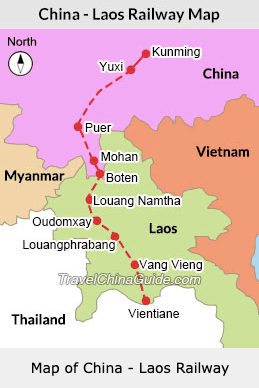
The next new railway project is about to commence construction from Vientiane to the port of Vung Ang on the Vietnamese coast. The Vietnamese government have agreed to allow Laos access to its deep water port at Vung Ang providing the only land-locked country in Southeast Asia with access to shipping in the South China Sea. This rail link will also connect to Vietnam’s north-south railway opening up the prospect of a Hanoi-Vientiane service. The total length of this line is 555km, 452 in Laos and 103 across Vietnam.
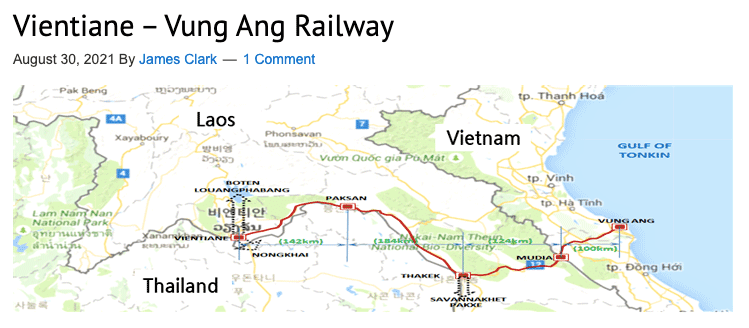
Live cattle discharged at the Vung Ang port could potentially be railed through Vietnam then Laos and on into southern China. A large cattle quarantine facility has already been constructed near Boten on the Chinese border.
March prices
These figures are converted to AUD$ from their respective currencies which are changing every day so the actual prices here are corrupted slightly by constant foreign exchange fluctuations. The AUD$ figures presented below should be regarded as reliable trends rather than exact individual prices. Where possible the meat cut used for pricing in the wet and supermarket is Knuckle / Round.
| Location | Date | Wet Market
AUD$/kg |
Super market
$/kg |
Broiler chicken
$/kg |
Live Steer
Slaughter Wt AUD$/kg |
| Indonesia | Oct 21 | 14.01 | 14.77 | 3.27 | 4.67 |
| Rp10,400 | Nov 21 | 14.42 | 15.19 | 3.85 | 4.80 |
| Rp10,200 | Dec 21 | 14.71 | 15.49 B13.04 | 4.21 | 4.80 |
| Rp10,200 | Jan 22 | 14.71 | 14.71 | 3.92 | 5.09 |
| Rp10,400 | Feb 22 | 14.42 | 14.33 | 3.65 | 5.05 |
| Rp10,500 | March 22 | 15.24 | 16.62 B9.38 | 3.62 | 5.05 |
| Philippines | Oct 21 | 13.49 | 14.28 | 3.17 | 3.44 |
| P36.9 | Nov 21 | 14.36 | 15.18 | 3.52 | 3.66 |
| P36.2 | Dec 21 | 14.64 | 15.47 | 3.59 | 3.73 |
| P36.5 | Jan 22 | 14.52 | 15.34 | 4.66 | 3.50 |
| P37.6 | Feb 22 | 14.10 | 14.89 | 4.52 | 3.40 |
| P38.3 | March 22 | 14.10 | 14.88 | 4.31 | 3.34 |
| Thailand | Oct 21 | 9.27 | NA | 3.02 | 3.27 |
| THB 24.4 | Nov 21 | NA | NA | NA | 4.51 |
| THB 24.0 | Dec 21 | NA | NA | 2.88 | 4.58 |
| THB 23.2 | Jan 22 | 11.59 | NA | 3.43 | 4.72 |
| THB 23.7 | Feb 22 | 11.39 | NA | 3.59 | 4.64 |
| THB 24.5 | March 22 | 11.02 | NA | 3.67 | 4.08 |
| Vietnam | Oct 21 | NA | 15.29 | 5.11 | 4.82 |
| D16,600 | Nov 21 | NA | 16.75 | NA | 4.94 |
| D16,300 | Dec 21 | NA | 16.75 | 4.91 | 5.03 |
| D16,200 | Jan 22 | 19.14 | 19.38 | 4.01 | 5.12 |
| D16,500 | Feb 22 | 18.79 | 16.18 | 7.09 | 5.09 |
| D16,800 | March 22 | 18.45 | 18.69 | 6.96 | 5.00 |
| China Beijing | Oct 21 | NA | NA | NA | NA |
| Y4.66 | Nov 21 | 18.88 | 21.46 | 4.25 | 7.51 |
| Y4.46 | Dec 21 | 20.63 | 23.00 | 4.22 | 7.94 |
| Y4.54 | Jan 22 | 21.15 | 21.72 | 4.23 | 7.75 |
| Y4.60 | Feb 22 | 20.89 | 21.43 | 4.17 | 7.65 |
| Y4.68 | March 22 | 20.51 | 20.94 | 4.44 | 7.56 |
| Shanghai | Oct 21 | 20.62 | 25.16 | 3.81 | 7.46 |
| Pork per kg | Nov 21 | 20.60 | 25.32 | 4.29 | 7.55 |
| Beijing Y21.8 | Dec 21 | 22.11 | 27.35 | 4.04 | 8.03 |
| ShanghaiY23.6 | Jan 22 | 21.71 | 26.43 | 4.01 | 7.84 |
| Feb 22 | 21.43 | 26.09 | 4.02 | 7.74 | |
| March 22 | 21.06 | 25.64 | 3.97 | 7.56 | |
| Darwin Feeder Steer | June 19
$2.90 |
July 19
$3.00 |
August 19
$3.15 |
Sept 19
$3.15 |
October 19
$3.30 |
| Nov 19
$3.35 |
Dec 19
$3.25 |
January 2020
$3.25 |
Feb 2020 $3.80 | March 2020
$3.40 |
|
| April 20
$2.80 |
May 20
$3.25 |
June 2020
$3.40 |
July 2020
$3.50 |
August 2020
$3.40 |
|
| Sept 2020
$3.45 |
October 2020
$3.90 |
Nov 2020
$4.00 |
Dec 2020
$4.00 |
Jan 21
$4.10 |
|
| Feb 21
$4.30 |
March 21
$4.30 |
April 21
$4.20 |
May 21
$4.10 |
June 21
$4.10 |
|
| July 21
$4.05 |
August 21
$4.25 |
Sept 21
$4.20 |
Oct 21
$4.30 |
November 21
$4.50 |
|
| December 21
$4.70 |
January 22
$5.35 |
February 22
$5.45 |
March 22
$5.53 |

